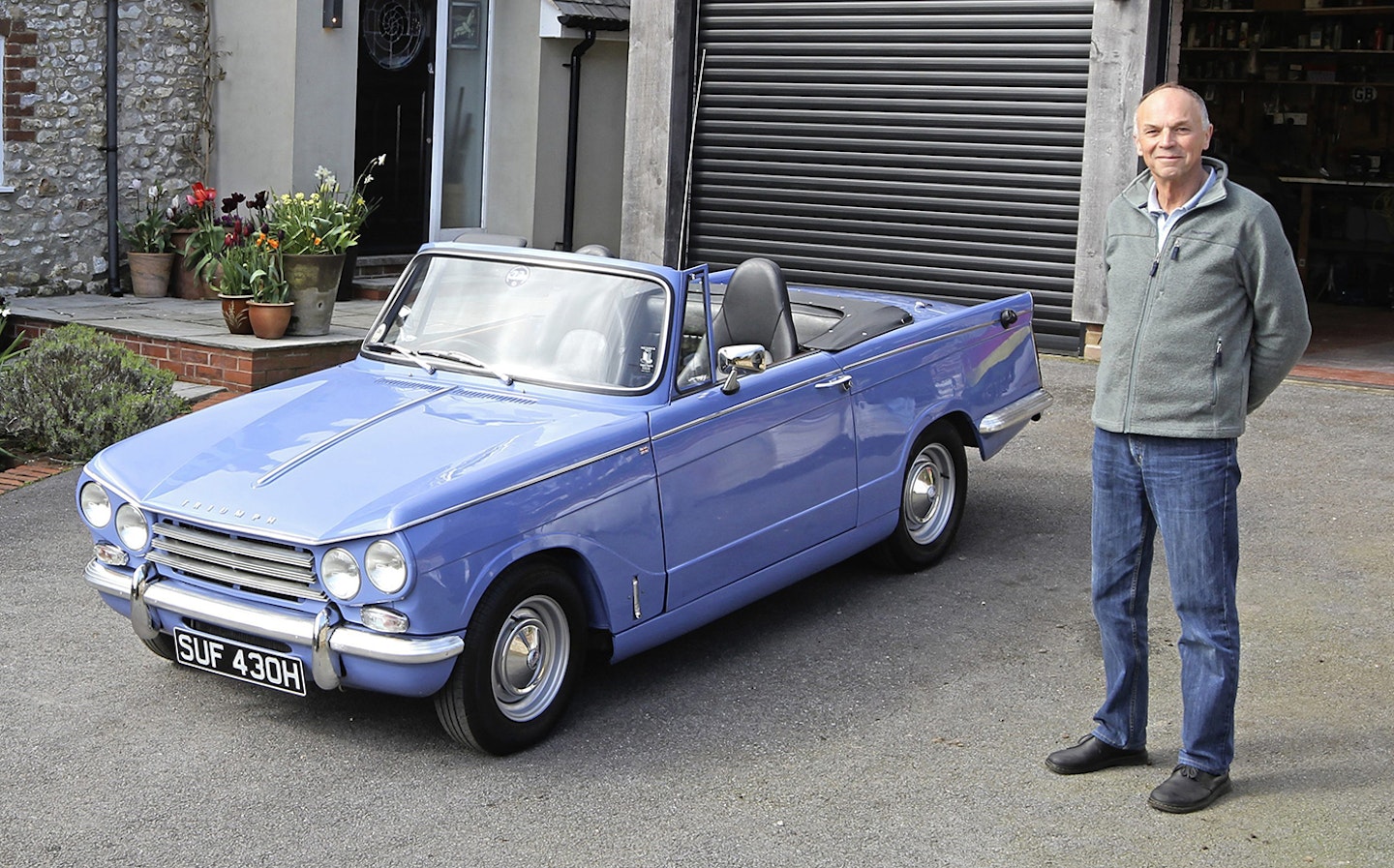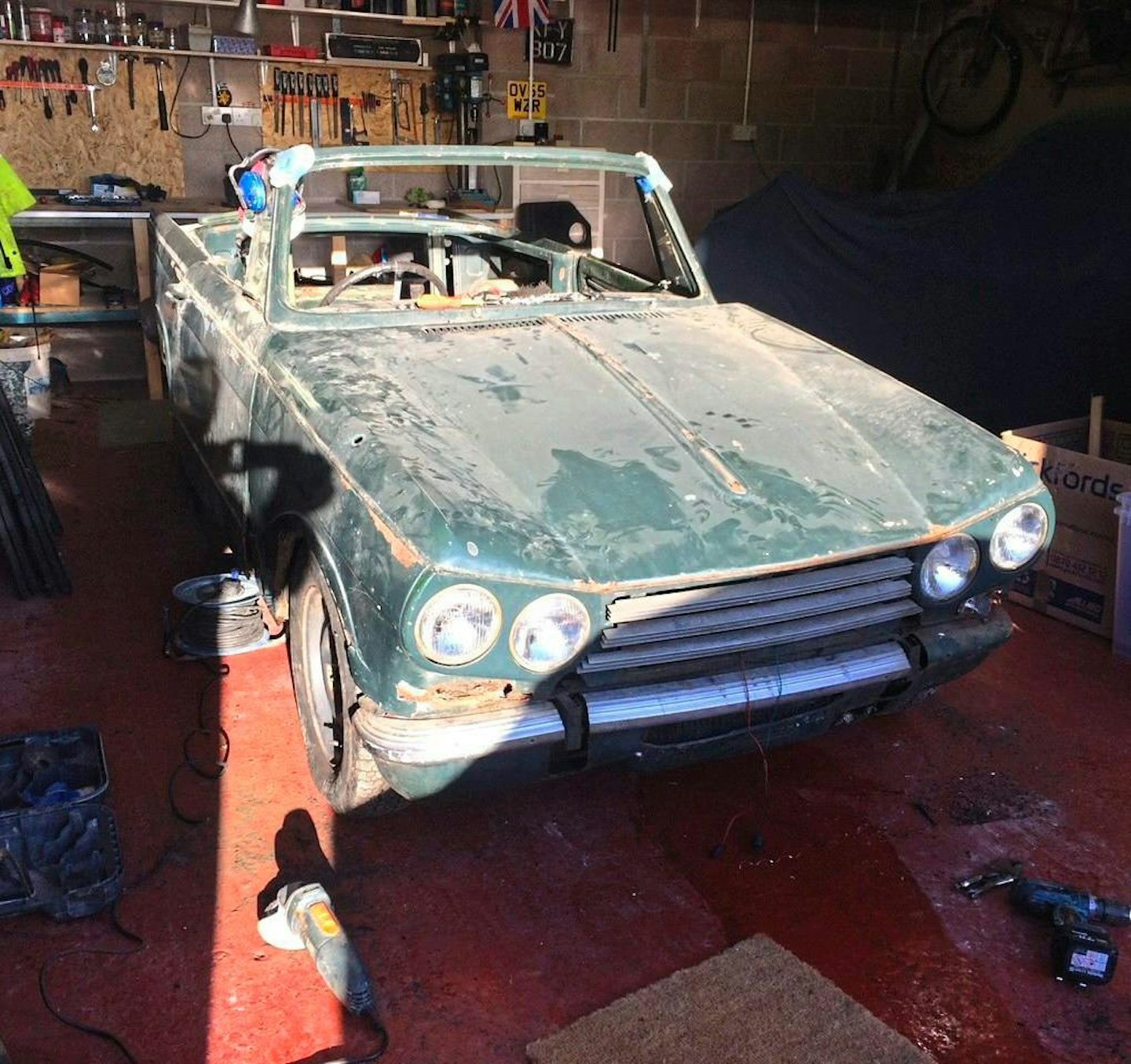READER’S STORY
Phil Coates’s welder had been gathering dust for 20 years, but he fired it up for this Vitesse
WORDS & PICTURES JAMES WALSHE

More than 20 years ago, my wife bought me a welder and I went to night school so I could learn to use it to restore my Jaguar XK150. Once finished, the welder got put on a shelf for 20 years until recently, when I fired it up again for a whole new project!
I dragged this Vitesse home – a MkII with overdrive. The car even came with replacement outriggers with Triumph labels still attached, as the previous owner hadn’t had the chance to fit them. I was relieved to find the chassis in good condition, aside from one patch that needed a repair, but the rest of the car was gone. Wheelarches, edge of the bonnet, all the floors… it was in a terrible state. The whole package was complete though. All the numbers matched!
Getting stuck in
The first big task was to sort those outriggers. I had a great diagrammatic view of the chassis, which came in handy, while advice from fellow members of the Triumph clubs and forums gave me a good insight. I did a lot of chatting, which allowed me to plan! When the work began, I measured everything, clamped some iron girders across the chassis and kept measuring until it was right, did a load of tack welding and measured again. It had been two decades since the welder had been out, so I was a bit rusty myself – the evidence being my pigeon turd welding getting steadily better as the restoration progressed! The bottom of the A-pillar was completely rusted out, and that was a tricky job but by the time I was doing the wheelarches, I had the power turned up and I was going well. Most of my panels came from Chic Doig in Scotland – he also gave me some great advice.

Meanwhile, the engine was the original 1970 item. Having got Hamlins Engineering in Bridgwater to machine it all for me, I rebuilt the unit and was chuffed with the result. I added a servo to the brakes, as I wanted them to be as effective as possible because there are a lot of hills here in Dorset! Standard procedure is to position the servo on top of the master cylinder, but I think it looks awful – as if it’s just been thrown there. I read that you can squeeze it near to the heater matrix if you use a smaller battery, so I did that. Talking of making improvements, I wanted seats that would be more comfortable for us both and while MGF items do fit, they’re a bit too wide for the Vitesse I think, so I used MX-5 seats bought from eBay.
Twenty years earlier, I had sent the Jaguar away for paint but this time, I wanted to have a go myself.
I had to build my own paint booth in the garden – a wooden frame with polythene sheets all fitted with an extractor device and filter. My wife was keen on pink or purple, so I nodded politely and then went for a period shade of Jaguar lavender instead!
I started on the sills and valances – all the areas away from the eyeline! It was easier than I thought – cellulose is very forgiving. I put five coats on, flatted it back and polished it. It feels like cheating, but I knew I could revisit the paint later if I needed to – or just give it to somebody else. Thankfully though, I haven’t needed to as I’m really pleased with how the car looks. We like to use it as often as possible as the Vitesse was built to be driven. They’re so much fun and that engine sounds terrific. Initial test run was the bi-annual Club Triumph Round Britain Reliability Run, 2000 miles in 48 hours, which I’m glad to say was completed without incident!
ENGINE
Vitesse MkII from 1968 to 1971 got a 104bhp version of the six-cylinder 1998cc unit. Phil had this engine machined, and the crank was fine – it just needed polishing.

BODY
Rust was present from the leading edge of the bonnet to the boot floor, so Phil had his work cut out. The bottoms of the A-pillars had gone, presenting a particular challenge.
SERVO
Phil added a brake servo, but instead of fitting it on top of the master cylinder, it slotted neatly into a place next to the smaller-than-standard battery.
INTERIOR
The cabin was mostly complete when Phil found the car, so plenty of cleaning saw it come up well. Seats are from aMazda MX-5.
Practical Classics Restorer of the Year 2025
Phil is entered into the 2025 Restorer of the Year competition. You can vote for your favourite in a future issue of Practical Classics magazine.
Subscribe to a PC Print+ Subscription today and you'll get instant digital access to this article PLUS FREE UK delivery so you'll never miss an issue again. With our festive offer, try your first 6 issues for £19.99.
